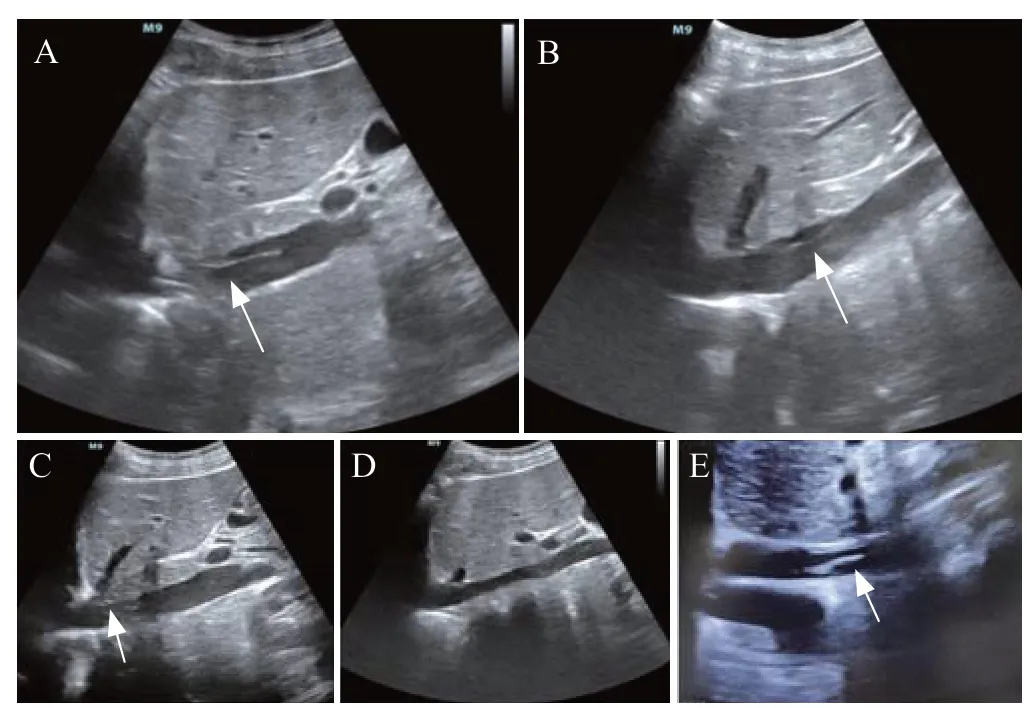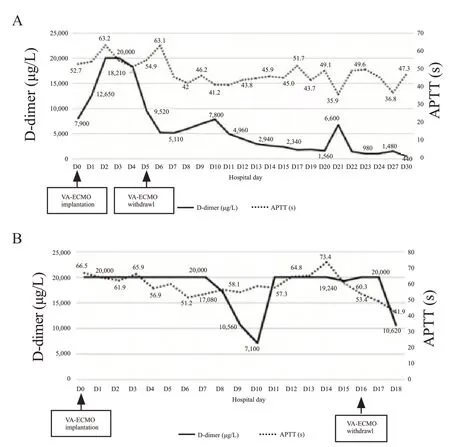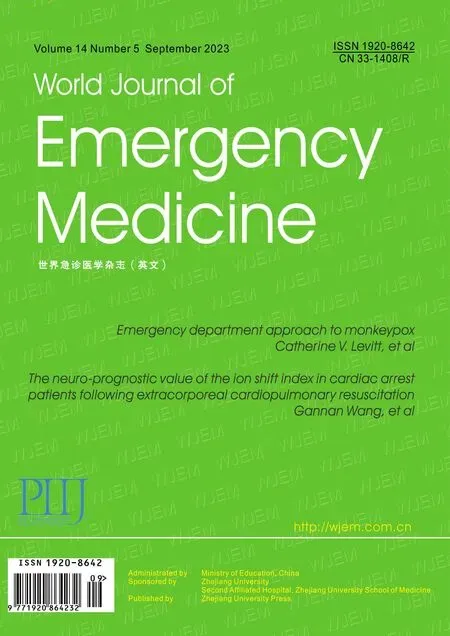Inferior vena cava thrombosis in two adult patients with veno-arterial extracorporeal membrane oxygenation
Xiao Chen,Anyu Qian,Mao Zhang,Guangju Zhou
Department of Emergency Medicine, the Second Affiliated Hospital of Zhejiang University School of Medicine, Hangzhou 310009, China
Veno-arterial extracorporeal membrane oxygenation(VA-ECMO) is indicated in patients with severe cardiogenic shock.During extracorporeal membrane oxygenation(ECMO) use,systemic anticoagulation is generally used to ensure the normal functioning of ECMO.Hemorrhage and thrombosis are two important complications of ECMO.However,despite adequate anticoagulation,some patients still experience thrombosis,such as inferior vena cava thrombosis (IVCT),after the removal of ECMO.[1,2]A metaanalysis showed that the incidence of venous thrombosis during ECMO treatment is approximately 10%,[3]but IVCT is rarely reported.We report two cases of IVCT after the removal of VA-ECMO cannulas.
CASE
Case 1
A 30-year-old woman fell into coma after being trapped in a fire.She had severe smoke inhalation injury and cardiac arrest.Transthoracic echocardiography(TTE) showed left ventricular ejection fraction (LVEF)< 10%,and she was treated with VA-ECMO because of circulation instability,with an estimated no-flow time of several minutes and low-f low time of 30 min.During VA-ECMO operation,the patient was anticoagulated with heparin to a target activated partial thromboplastin time (APTT) of 50-70 s and activated clotting time(ACT) of 160-200 s.ECMO was successfully weaned after 6 d due to the recovery of cardiac function.Then,heparin was stopped,and subcutaneous low-molecularweight heparin (LMWH) was administered at an initial dose of 40 mg once daily to prevent deep venous thrombosis.TTE after ECMO removal showed cable floating objects in the inferior vena cava (IVC) (Figure 1A) with a tail swing,which was considered to be IVCT.After comprehensive evaluation of the risk of bleeding and thrombosis,the maintenance dose of LMWH was adjusted to 20 mg twice daily subcutaneously.Daily TTE examinations showed that the thrombosis gradually decreased (Figures 1 B and C),and after two weeks of anticoagulant therapy,the thrombosis finally disappeared(Figure 1D).The D-dimer level steadily decreased during LMWH treatment (Figure 2A).However,the patient was clinically diagnosed with brain death and declared clinically dead.
Case 2
A 49-year-old man with severe triple vessel disease was treated with extracorporeal cardiopulmonary resuscitation (ECPR);then,he was transferred to our hospital and received percutaneous coronary intervention(PCI).His LVEF reached 30% after one week of PCI,and VA-ECMO was successfully removed.Routine TTE evaluation after ECMO withdrawal revealed short-segment strip thrombosis in the IVC (Figure 1E).Because the patient continued to receive continuous renal replacement therapy,heparin was used to maintain his APTT between 50 s and 70 s (Figure 2B),and this was the treatment for the IVCT.The patient was transferred back to the local hospital two days after ECMO withdrawal.At discharge,his overall condition was better than that at admission,but IVCT still existed,possibly due to an insufficient anticoagulant course.
DISCUSSION

Figure 1.The subxiphoid view of TTE of case 1 (A-D) and case 2 (E).A: IVCT detected by TTE after ECMO withdrawal (arrow);B: one week after ECMO withdrawal,the IVCT decreased in size through anticoagulation therapy (arrow);C: ten days after ECMO withdrawal,the IVCT almost disappeared with anticoagulation therapy (arrow);D:the IVCT disappeared after two weeks of anticoagulation therapy;E:IVCT of case 2 after ECMO withdrawal (arrow).TTE: transthoracic echocardiography;ECMO: extracorporeal membrane oxygenation;IVCT: inferior vena cava thrombosis.

Figure 2.The D-dimer and APTT of case 1 (A) and case 2 (B).VAECMO: veno-arterial extracorporeal membrane oxygenation;APTT:activated partial thromboplastin time.
Some patients have been found to have IVCT during or after ECMO use.The incidence of IVCT secondary to ECMO catheterization is difficult to determine.However,similar to ECMO catheterization,the incidence of filterrelated IVCT is approximately 2%.[4]The symptoms of IVCT may be varied;some patients are asymptomatic,[1]some patients develop inferior cava syndrome,[5]and some patients even develop fatal pulmonary embolism.[6]The mortality of ECMO catheter-related thrombosis (CRT)depends more on the severity of the primary disease.IVCT is difficult to detect during ECMO use and is usually inadvertently discovered by ultrasound examination or CT scan after ECMO withdrawal.[1,7]Possible risk factors for cannula-associated IVCT include blood loss,hypovolemia,persistent tube shaking,slow blood flow,[8]low-intensity anticoagulation or non-heparin anticoagulation,prolonged ECMO use,and previous infection.[9]Moreover,the larger the diameter of the catheter is,the higher the risk of thrombosis.[10]In the two patients reported here,thrombosis was detected by TTE after ECMO removal,which may be related to the vascular endothelium injury during ECMO catheterization.
There are no therapeutic guidelines pertaining to IVCT.Shi[11]reviewed the etiology and treatment of acute IVCT and detailed the various treatment options,including systemic anticoagulation and endovascular strategies.The two patients with asymptomatic IVCT in this report were given standard anticoagulant therapy in accordance with the guidelines to avoid further thrombotic progression.[12]Other treatments for ECMO catheter-related thrombosis,such as thrombolysis and vascular interventional therapy,have not been recommended and are rarely reported.[13]Elhassan et al[6]reported a case of fatal ECMO catheter-related thrombosis in which thrombectomy was performed after the evaluation of the thrombus size and mobility and after individualized patient-based assessment of embolism risk,which provides a reference for the acute management of this condition.
For patients with ECMO support,dynamic ultrasound evaluation during ECMO use and after withdrawal is necessary.[14]Ultrasound also plays an important role in thrombosis monitoring of other invasive catheters.Wu et al[15]recently published a large multicenter prospective study of ultrasound monitoring of CRT and found that the incidence of CRT was 16.9%,which highlighted the importance of ultrasound in thrombosis monitoring.The two cases of IVCT reported here were detected during daily ultrasound evaluation and were monitored daily during anticoagulant therapy.Ultrasound is noninvasive,inexpensive,and reproducible.Trained operators can perform realtime bedside ultrasound,which not only enable fine management under ultrasound guidance but also facilitate timely detection of thrombosis and early treatment.
CONCLUSION
IVCT may occur after ECMO catheterization for various reasons.Anticoagulant therapy is an effective and primary treatment for ECMO catheter-related IVCT.Ultrasound can be used for the detection and follow-up of IVCT during ECMO use or after ECMO withdrawal.
Funding:None.
Ethical approval:This study was approved by Ethical Committee of the Second Affiliated Hospital of Zhejiang University School of Medicine.
Conf licts of interests:The authors declare no conf licts of interest.
Contributors:XC proposed the study and wrote the paper.All authors contributed to the design and interpretation of the study.
 World journal of emergency medicine2023年5期
World journal of emergency medicine2023年5期
- World journal of emergency medicine的其它文章
- Acute hemolytic anemia in a 34-year-old man after inhalation of a volatile nitrite “popper” product
- Severe disseminated intravascular coagulation complicated by acute renal failure during pregnancy
- Key elements and checklist of shared decisionmaking conversation on life-sustaining treatment in emergency: a multispecialty study from China
- Establishment and evaluation of animal models of sepsis-associated encephalopathy
- Open surgical approach for two coincidental splenic artery aneurysms: a case report
- Progressive eschar-like wound and peripheral neurological dysfunction with severe inf lammatory status: infection or unnatural immune response?
